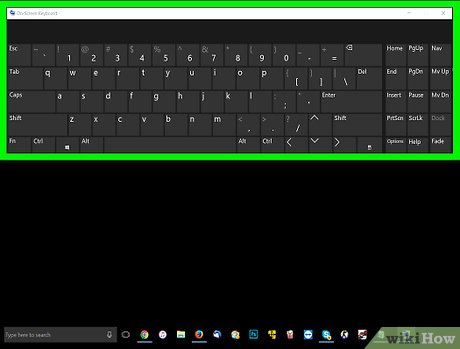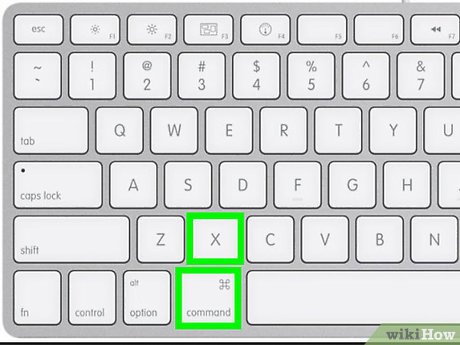How to Use Keyboard Shortcuts
Method 1 of 2:
Windows
 Understand how key shortcuts work. To use a key shortcut, you will hold down one or more modifier keys and press a letter (or another modifier key). Modifier keys include the following:[1]
Understand how key shortcuts work. To use a key shortcut, you will hold down one or more modifier keys and press a letter (or another modifier key). Modifier keys include the following:[1] - Ctrl - Usually found on the left and right sides of the keyboard. The right Ctrl key will be just left of the arrow keys.
- Alt - Found on the left and right sides of the keyboard, farther in toward the center of the keyboard than Ctrl.
- ⇧ Shift - Symbolized by an upward-facing arrow, this key is on the left and right sides of the keyboard.
- Fn - The "function" key allows you to use secondary functions of other keys. Commands that use the function keys (e.g., F8) may require use of the Fn key.
- ⊞ Win - This key displays the Windows logo, and is normally in the bottom-left side of your keyboard.
- Arrow keys - While not technically modifier keys, the arrow keys can be used to select items.
- ↵ Enter - This key allows you to open a selected item. It's essentially a mouse left-click.
 Use general key shortcuts to access Windows features. These combinations help you perform basic Windows tasks:
Use general key shortcuts to access Windows features. These combinations help you perform basic Windows tasks: - F1 - Open the Help page. You must have Internet access for this. If your computer has an Fn key, you may need to hold it while pressing F1.
- ⇧ Shift+F10 - Bring up the context menu for a selected item. This is usually accomplished by right-clicking.
- Ctrl+⇧ Shift+Esc - Open the Task Manager.
- Ctrl+Alt+Del - Open the Windows Security menu. (works from XP to 10)
- Alt+Space - Bring up the current window's System menu, from which you can resize, minimize, maximize, or move the current window.
- Ctrl+Tab ↹ - Move through current window's tabs (e.g., in a browser).
- Ctrl+Esc - Open the Start menu.
- Alt+Tab ↹ - Switch between currently open windows, excluding the desktop.
- Alt+F4 - Close an open window or program.
- ⇧ Shift+Delete - Permanently delete a selected item. This will bypass the Recycle Bin, though you'll need to click OK to confirm.
- ⊞ Win - Open Start.
- ⊞ Win+L - Lock the computer. If your computer doesn't use a password, this will still take you to the user selection screen.
- ⊞ Win+R - Open the Run box.
- ⊞ Win+M - Minimize all open windows and display the desktop.
- ⇧ Shift+⊞ Win+M - Restore all minimized windows.
- ⊞ Win+E - Open File Explorer.
- ⊞ Win+Ctrl+F - Find another computer on your network (networked computers only).
- ⊞ Win+Tab ↹ - View all currently open Windows.
- ⊞ Win+⎊ Break - Open the System Properties window.
- ⊞ Win+⎙ PrtScr - Take a screenshot.
- Ctrl+F - Open a search bar to look for specific words or phrases on the page.
 Use keyboard shortcuts to help with typing, copying, and pasting. There are several text-editing shortcuts in Windows that extend to most instances of typing, as well as file copying and pasting:
Use keyboard shortcuts to help with typing, copying, and pasting. There are several text-editing shortcuts in Windows that extend to most instances of typing, as well as file copying and pasting: - Ctrl+C - Copy selected text. You can also use this to copy selected files or folders.
- Ctrl+X - Copy and remove selected text (known as "cutting").
- Ctrl+V - Paste copied text at the cursor. This also works with files and folders.
- Ctrl+Z - Undo the last action. Depending on the program, this command can be used multiple times to undo multiple mistakes.
- Ctrl+Y - Reverse the last undo. Depending on the program, this command can be used multiple times to revert multiple undo commands.
- Ctrl+P - Print your document.
- Ctrl+S - Save your document.
- Ctrl+B - Bold the selected text. This will work in Microsoft Office products and most email providers.
- Ctrl+U - Underline the selected text. This will work in Microsoft Office products and most email providers.
- Ctrl+I - Italicize the selected text. This will work in Microsoft Office products and most email providers.
 Use keyboard shortcuts in File Explorer. There are a few keyboard shortcuts you can use to navigate in the File Explorer:
Use keyboard shortcuts in File Explorer. There are a few keyboard shortcuts you can use to navigate in the File Explorer: - F2 - Rename a selected item.
- F4 - Places the mouse cursor in the address bar.
- F5 - Refreshes the folder.
- F6 - Selects a different pane in the File Explorer window.
- Ctrl+A - Selects every item in the current window.
- Alt+↵ Enter - Open a selected item's Properties menu.
 Use key shortcuts with the mouse. Most programs have an advanced menu that can be accessed using the mouse while pressing a key:
Use key shortcuts with the mouse. Most programs have an advanced menu that can be accessed using the mouse while pressing a key: - ⇧ Shift + Right-Click - Shows a drop-down menu with extra options based on the item you're right-clicking.
- ⇧ Shift + Double-Click - Runs the alternate double-click command, which is the second option in the right-click drop-down menu.
- Alt + Double-Click - Open an item's Properties window.
Method 2 of 2:
Mac
 Understand how key shortcuts work. To use a key shortcut, you will hold down one or more modifier keys and press a letter (or another modifier key). Modifier keys include the following:[2]
Understand how key shortcuts work. To use a key shortcut, you will hold down one or more modifier keys and press a letter (or another modifier key). Modifier keys include the following:[2] - ⌘ Command - Located on the left and right sides of the spacebar.
- ⌥ Option - Located next to the ⌘ Command keys.
- Control - Located on the left side of the keyboard.
- Fn - Located in the bottom-left side of the keyboard. This key activates the alternative uses for the "Function" keys (e.g., F8).
- ⇧ Shift - Located on the left and right sides of the keyboard.
- Arrow keys - While not technically modifier keys, the arrow keys can be used to select items.
- ⏎ Return - Located on the right side of the keyboard. Allows you to open a selected item.
 Use keyboard shortcuts for common actions. Instead of using the mouse or a program's buttons, you can use your Mac's keyboard to do things like copying files or text, and opening certain programs:
Use keyboard shortcuts for common actions. Instead of using the mouse or a program's buttons, you can use your Mac's keyboard to do things like copying files or text, and opening certain programs: - ⌘ Command+X - Copy selected text or file, then delete it from the current location (also called "cutting").
- ⌘ Command+C - Copy selected text or file without deleting it.
- ⌘ Command+V - Paste a copied item.
- ⌘ Command+Z - Undo the last command.
- ⌘ Command+⇧ Shift+Z - Redo the last command if you used the Undo command.
- ⌘ Command+A - Select all items in your current folder.
- ⌘ Command+F - Open the search bar in a specific window, browser, or program.
- ⌘ Command+G - Find the next instance of an item (e.g., a word) you searched for.
- ⌘ Command+⇧ Shift+G - Find the previous instance of an item you searched for.
- ⌘ Command+H - Hide the front (currently open) app or program's window.
- ⌘ Command+⌥ Option+H - Hide all windows except the front app or program.
- ⌘ Command+M - Minimize the front window.
- ⌘ Command+⌥ Option+M - Minimize all front app's windows.
- ⌘ Command+N - Open a new document, window, or tab depending on the program you're using.
- ⌘ Command+O - Open a selected item (e.g., a file or folder).
- ⌘ Command+P - Print the current document.
- ⌘ Command+S - Save your current document.
- ⌘ Command+Q - Quit the front app.
- ⌘ Command+Esc - Open the Force Quit menu.
- ⌘ Command+⇧ Shift+⌥ Option+Esc - Hold for three seconds to force-quit the front app.
- ⌘ Command+Space - Bring up the Spotlight search bar.
- ⌘ Command+Tab ↹ - Switch to the next open app.
- ⌘ Command+⇧ Shift+~ - Switch to the next window of the front app.
- ⌘ Command+⇧ Shift+3 - Take a full-screen screenshot.
- ⌘ Command+, - Open the front app's preferences.
 Make your computer sleep, log out, or shut down. There are several shortcuts you can use to lock down your computer quickly:
Make your computer sleep, log out, or shut down. There are several shortcuts you can use to lock down your computer quickly: - Control + Power button - Bring up the Sleep/Restart/Shut down menu.
- Control+⌘ Command + Power button - Force your Mac to reboot.
- Control+⇧ Shift + Power button - Shut off your Mac's screen.
- Control+⌘ Command + Media eject button - Quit all apps, then restart.
- Control+⌥ Option+⌘ Command + Power button - Quit all apps, then shut down.
- ⇧ Shift+⌘ Command+Q - Brings up a prompt that, when accepted, logs you out of your account.
- ⌥ Option+⇧ Shift+⌘ Command+Q - Logs you out of your account without asking to confirm.
 Use shortcuts to navigate the Finder. You can use keyboard shortcuts to perform several actions inside of the Finder:
Use shortcuts to navigate the Finder. You can use keyboard shortcuts to perform several actions inside of the Finder: - ⌘ Command+D - Duplicate selected items.
- ⌘ Command+E - Eject a selected drive (e.g., flash drive).
- ⌘ Command+F - Open Spotlight in the Finder.
- ⌘ Command+I - Display the Get Info window for a selected item.
- ⌘ Command+⇧ Shift+C - Open the Computer folder.
- ⌘ Command+⇧ Shift+D - Open the Desktop folder.
- ⌘ Command+⇧ Shift+F - Open the All My Files folder.
- ⌘ Command+⇧ Shift+G - Open a Go to Folder search.
- ⌘ Command+⇧ Shift+H - Open your Mac's Home folder.
- ⌘ Command+⇧ Shift+I - Open iCloud Drive.
- ⌘ Command+⇧ Shift+K - Open the Network window.
- ⌥ Option+⌘ Command+L - Open the Downloads folder.
- ⌘ Command+⇧ Shift+O - Open the Documents folder.
- ⌘ Command+⇧ Shift+R - Open the AirDrop utility.
3.9 ★ | 7 Vote
You should read it
- Computer stuck on shift button, power button, ctrl - Quick fix in 7 ways
- Does the keyboard shortcut Win + Ctrl + Shift + B make Windows computers run faster?
- How to open links in Word, Outlook does not need the Ctrl key
- Instructions for activating Night Shift on iOS 9.3
- How to open Command Prompt on Windows 10, 8, 7, Vista and XP
- How to open Microsoft Word from Command Prompt









 How to Format a Hard Drive
How to Format a Hard Drive How to Change Startup Programs on Your Computer
How to Change Startup Programs on Your Computer How to Exit out of a Frozen Computer Program
How to Exit out of a Frozen Computer Program How to Enter Data in SPSS
How to Enter Data in SPSS How to Install Two Operating Systems on One Computer
How to Install Two Operating Systems on One Computer How to Install Chromium OS
How to Install Chromium OS